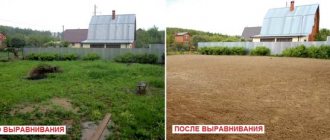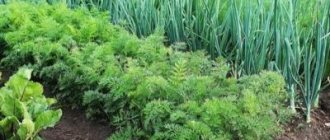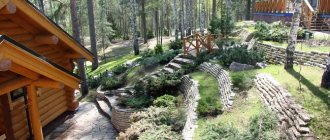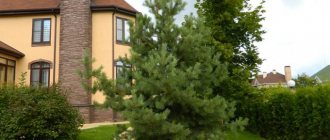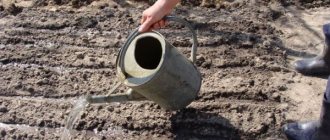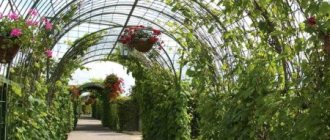The land market has been as active as never before in the last six months. This means that the percentage of transactions made in a hurry, when the future homeowner buys a “pig in a poke”, having a vague idea of the boundaries of the site, and the nature of the soil, and how to cultivate it, has also increased.
Today, when many novice homeowners find themselves face to face with their newly purchased acres of land, it is appropriate to talk about where to start developing the land. Specialized Internet forums show that this topic is one of the most relevant. After all, the vast majority of new sites do not at all resemble a ground lawn or a putting green.
Beginning of work
An overgrown area presents a bleak picture.
A lot of dry weeds with strong roots, wild bushes and semi-dry old trees - this is a considerable list of work that requires attention. Heaps of garbage, remains of building materials, and dilapidated buildings are also not uncommon here.
It is difficult to imagine ideal beds, spectacular flower beds or a lawn in an overgrown area. How to develop an overgrown site and make it suitable for use? Before planting flowers, sowing seeds or making a beautiful lawn in an overgrown area, you will have to work hard. Development of a heavily overgrown area requires attention and physical strength, so improvement begins with small areas.
There is a lot of work ahead. It will only take a few years to achieve a beautiful, attractive look. How to develop an overgrown plot for a vegetable garden and where to start?
- Dismantle unnecessary buildings and remove construction waste.
- Collect large debris throughout the area.
- Remove unnecessary trees and shrubs. To remove the top part, use a saw or hacksaw. The roots need to be uprooted, this will help prevent the bush from growing throughout the area in the future. To remove roots, use a winch or brush cutter.
- Dry weeds are mowed down and removed from the territory.
- The land is plowed or dug up by hand. All roots require careful removal.
That's all! You can start planting and start designing your yard.
All of the above measures will help get rid of weeds and weeds. However, many roots remain in the ground, which in a few weeks will delight summer residents with their appearance. How to clean an overgrown summer cottage and prevent the massive appearance of weeds? Let's consider several options.
Assessment of the condition of buildings located on the site
Often on the site, in addition to the house, there may be a barn, a garage, a gazebo, a bathhouse, a toilet, a shower, and a workshop. All these buildings, if any, must be carefully inspected. Perhaps something will have to be disassembled immediately due to its emergency condition. You can invite a construction specialist for an inspection, who will advise on the feasibility of repairs and its estimated cost. Of course, this will not be cheap, so it is important to set priorities and determine the order of repair work. You should inspect the buildings in advance to understand which types of work can be done on your own and which cannot be handled without the help of a professional.
Remember that sometimes demolishing the old and installing a new one is much cheaper than repairing.
Herbicides
Processing and improving a large overgrown area takes several years. However, this process can be accelerated. Herbicides are very effective in controlling weeds. They are used before they are going to dig up an overgrown area and plant vegetables and flowers on it.
It is better to use continuous herbicides aimed at destroying all excess vegetation. The first treatment is carried out in early spring before the formation of inflorescences. Herbicides are sold as dry powder or in concentrated liquid form. Breed according to instructions, taking personal safety measures.
A sprayer is used to treat large areas. Small areas of land can be watered with a watering can. Once on the leaf blades of plants, herbicides penetrate into the roots. The first results of the treatment will be visible within a few days - the weeds turn pale and dry out completely within a few weeks. After 1.5 months, the treatment can be repeated to consolidate the result.
Site design and drilling of water wells
After general cleaning, it is necessary to invite a geologist who will manually drill wells on all sides of the site and determine the nature of the soil. He will also share information about the level of groundwater, which helps to significantly adjust the landscape plan. The specialist will advise where to dig a well and a septic tank.
Some attention should be paid to the location of the drainage ditch located near the road. Before starting to design the site, you need to know where the underground communications will be located: - electricity supply, sewerage, gas pipeline and water supply. This document can be obtained from a dacha cooperative or BTI, in possession of which the owner will be confident when constructing a dacha house or planting trees.
Planting garden trees should be oriented according to the cardinal directions. Gardeners believe that afternoon sun has a positive effect on various types of plants. Shrubs and low trees should be located closer to the sun's rays, and tall plantings should be placed behind them.
Green manure
An effective way to clear a site of weeds is to sow green manure.
They inhibit the growth and development of weeds and suppress the root system. Any plant with a strong root system can be used as green manure:
- rye;
- white mustard;
- rape;
- clover;
- alfalfa;
- oats;
- sweet clover;
- peas.
If it is planned to plant vegetables on a cultivated plot this season, green manure must be selected from unrelated groups.
The use of green manure is carried out according to the following scheme:
- Clearing the area of dry grass.
- Plowing or manually digging up the soil and removing roots.
- Sowing.
- After a short period of growth, the green manure is mowed and put into compost pits or the soil is plowed together with the plants. In this case, green manure is used as mulch.
In spring, green manure is sown several weeks before planting. Autumn green manure is harvested in the spring. They optimize the acidity of the soil, promote its loosening and saturate it with oxygen. The use of green manure allows you to avoid the stage of applying fertilizers.
We remove harmful weeds
In the fall, after harvesting, you need to remove all weeds, especially those with thick roots, from which they can begin to grow again - dandelion, wheatgrass, sow thistle, burdock (burdock). We remember that sow thistle is also harmful because it collects aphids. Another one of the most annoying and difficult to remove weeds is cress; it is bad not only because it spreads across the ground at an unprecedented speed, but also because it attracts the cruciferous flea beetle. Weeding can be done even in October, before the soil “sets” after a hard frost.
Black film
It is very easy to tidy up a small overgrown area. But where to start if its dimensions are impressive and manual processing is an impossible process? How to easily and effortlessly clear an overgrown area of small bushes? How to permanently remove weeds from an abandoned, heavily overgrown area and never think about them again?
Black film comes to the rescue. It is spread over the entire surface, the edges are carefully secured.
In the absence of sunlight, plants cannot carry out the photosynthesis processes necessary for life and development. First, the weeds change color. Gradually, complete death of the root system occurs. Dead roots can be removed from the ground by hand or left to decompose naturally.
Black film can be replaced with any available material:
- cardboard;
- roofing felt;
- old carpets;
- board.
The only requirement for the material is that the coating should not transmit light. This method takes a lot of time. Effective microorganisms can be used to speed up the processes of death and removal of roots.
After treating the area, various bacteria and microorganisms are included in the cleaning processes. Weeds die off much faster. After just two months, the result is visible - the top part of the weeds has decomposed.
Now it is easy to clear the area of dry grass and loosen the soil. By next spring, the entire root part of the weeds will completely disappear and you can begin the exciting task of improving the area.
In the first year you can get impressive harvests here, and after a season you can use the site as a permanent place for perennial plants and flowers.
A small amount of weed is treated according to a different scheme:
- Autumn treatment with effective microorganisms.
- Sowing green manure with the onset of the first spring days.
- When the green manure grows a little, the ground is dug up or processed with a flat cutter, using green manure as mulch.
This method makes it easy to clear the area of thickets and preserve the soil structure. The result is soft, fluffy soil suitable for efficiently growing vegetables and flowers.
Cleaning up the area
Once large unnecessary items are thrown out of the site and the grass is mowed, it will become clear what kind of soil is on it and what other work is required for improvement. It is worth walking around the perimeter again, collecting small debris so that you can mow the grass with a trimmer to its minimum size. After this, you can mark the places where flower beds, vegetable beds, bushes and fruit trees will be located. The level of light and shadow should be taken into account so that future plants feel as comfortable as possible. You can think about the location of the recreation area. To install a gazebo, you may need to compact the ground and level it by making an embankment of crushed stone and sand. We recommend reading several interesting articles about landscaping a summer cottage: growing flowers in flowerpots and pots, arranging a flower garden, alternatives to a lawn, choosing garden furniture.
You can invite a landscape designer, he will clearly plan your garden space and select the right plants.
If your immediate plans include building a house or renovating buildings, then the improvement of the site should be postponed or moved to an area that will not be affected by destruction from equipment and construction waste.
Source
Lawn
An overgrown area can be improved and used not only for growing vegetables. We'll look at how to make a beautiful lawn in an overgrown area below. The best time for this is early spring, when the earth warms up to 10 °C.
Before digging the overgrown area with a shovel under the lawn, it is cleared of debris and dry grass. The turf is removed and all the soil is carefully dug up. The land needs complex nitrogen-containing fertilizers, which are applied during soil cultivation.
To get a smooth, beautiful lawn, the soil is leveled with a rake and thoroughly compacted.
The best time to sow lawn grass is after a good spring rain, when the soil is well saturated with water. During the dry period, it will be necessary to provide preliminary watering of the entire territory. The seeds are scattered evenly over the area, deepened into the ground using a rake.
After just 10 days, the first shoots appear. To maintain a beautiful appearance, the lawn needs to be mowed every three weeks.
Inspection of the site area
After you have mowed the grass and opened up the area, you should walk around it, carefully examining every corner. Firstly, you can find a lot of useful and interesting things - bricks, sheets of iron, mesh, pipes - all this will be useful for further repairs. Secondly, by assessing the conditions, area, and location features of the place on site, you can come up with a lot of options for its improvement, which should be written down in a notebook, so that you can then bring it to mind and bring it to life.
Photo from https://images.glaciermedia.ca
Results
Tidying up an overgrown area is quite labor-intensive and time-consuming. However, a set of chemical and mechanical measures, desire and limitless patience will help restore order and improve any abandoned area.
Related Posts
- Vinegar and salt based weed killer
- Excellent against weeds in garden beds
- How to get rid of purslane
- How to get rid of the weed Pigweed
- How to get rid of weeds on strawberries
- Annual and perennial cereal weeds
- The width is thrown back: description and control measures
- How to get rid of thistle
Is it necessary to dig up the soil in the fall?
If you have time and strength, both physical and moral, you can prepare both a potato plot and beds in the fall. If you dig with a shovel or with a tractor, you don’t need to break up large clods of earth; they will participate in snow retention. Such soil treatment helps to curb the growth of weeds, since their roots are carried out and some specimens die.
But sometimes there is not enough time for autumn digging. Then you can convince yourself that you are a fan of organic farming and spread mulch over the beds :). And yet, I note that it is very desirable to do at least one of the two listed actions: either digging, or mulching, or better yet, both.
How do you till the soil in the fall? Maybe you have some secret for quickly preparing beds for the ground? Share in the comments to the article! Have a rich harvest everyone!
